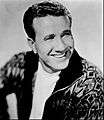Fuzz bass facts for kids
Fuzz bass (also called "bass overdrive" or "bass distortion") is a special sound for the electric bass. It makes the bass sound buzzy and distorted, almost like a growl! You can get this sound by turning up a bass amplifier really loud. Or, you can use a small electronic device called a "fuzz pedal." This unique sound became popular in the mid-1960s.
The 1965 Beatles song "Think for Yourself" has fuzz bass. Also, the 1966 Rolling Stones song "Under My Thumb" uses this cool sound.
Contents
What is Fuzz Bass?
Fuzz bass is a type of sound effect. It changes the normal, clear sound of an electric bass guitar. When you hear fuzz bass, it sounds thick, rough, and sometimes a bit like a buzzing bee. This makes the bass stand out more in a song.
How the Fuzz Sound is Made
There are two main ways to create the fuzz bass sound:
- Turning up the amplifier: Imagine turning your bass amp so loud that the sound starts to break up. This is called "overdriving" the amplifier. When an amp is overdriven, it naturally creates a distorted, fuzzy sound.
- Using a fuzz pedal: A fuzz pedal is a small electronic box. You plug your bass into it, and then the pedal into your amplifier. This pedal changes the sound signal from your bass. It adds extra "harmonics" and clips the sound waves. This makes the bass sound much thicker and more powerful.
Many bass players use fuzz pedals to get their unique sound. Some amplifiers even have a fuzz effect built right into them!
History of Fuzz Bass
The fuzz bass sound first appeared in the early 1960s. It quickly became popular in many types of music.
Early Fuzz Bass Songs
One of the first known songs to use fuzz bass was "Don't Worry" by Marty Robbins in 1961. This song showed how cool and different the sound could be.
In 1965, Paul McCartney used fuzz bass on the Beatles song "Think for Yourself" from their album Rubber Soul. This helped make the sound famous. The next year, in 1966, Bill Wyman played with a growling fuzz bass tone on the Rolling Stones song "Under My Thumb" from their album Aftermath.
Fuzz Bass in Different Music Styles
Over the years, fuzz bass has been used in many kinds of music.
- Rock and Blues: Bands like Cream, with bassist Jack Bruce, often used fuzz bass. It added a powerful, raw edge to their rock and blues songs.
- Heavy Metal and Punk: In heavier music, fuzz bass makes the sound even more intense. Bassists like Lemmy Kilmister from Motörhead often used a very loud, overdriven sound. This created a natural fuzz tone that was perfect for their fast and loud music.
- Grindcore: Bands in genres like grindcore, such as Napalm Death, use very heavy and grinding bass distortion. This creates a powerful wall of sound.
Fuzz bass continues to be a popular effect today. It helps bass players create exciting and unique sounds in all kinds of music.
Images for kids
-
The first known musical recording to use the fuzz bass was Marty Robbins's 1961 song "Don't Worry".
-
Paul McCartney, in one of the earliest uses of the fuzz bass, played the guitar on the 1965 Beatles song "Think for Yourself" from their album Rubber Soul.
-
Bill Wyman in one of the earliest uses of this type of guitar played with a growling fuzz bass tone on the 1966 Rolling Stones song "Under My Thumb" from their album Aftermath.
-
Jack Bruce from Cream, shown here performing in 1972, often played with a fuzz bass tone.









